The Cleckheaton Colliery Co. Ltd began sinking this mine, near Tong Street, in 1913. The company was a group of local men, either called Ellison or Sharp, it worked Toftshaw Moor until the end of 1946 when it was nationalised. The 86.6 metre deep shaft passed through the 0.6 metres thick Blocking coal at 24.4 metres. It was never worked by Toftshaw Moor and may either have been considered too shallow in an increasingly built-up area, or it may have already been worked by another mine.
The colliery had pithead baths, opened in 1934, long before many larger mines.
The principal source of coal came from the Shertcliffe seam, which 0.68 metres thick at a depth of 86.6 metres. The Black Bed, which was discontinued in November 1927, the only year in which it was worked, is 67.7 metres below Beeston.
When the National Coal Board took over Toftshaw Moor in 1947 the reserves Shertcliffe, or Beeston, coal was getting depleted. It closed the mine in August 1950.
Further reading:
- NMRS Records, Gazetteer of British Collieries
- Colliery Year Book and Coal Trades Directory, (The Louis Cassier Co. Ltd, 1923)
- Sections of Strata of the Yorkshire Coalfield, (Midland Institute of Mining Engineers, 1927)

OS Map, Yorkshire CCXVII.SW 1944
Reproduced by permission of the National Library of Scotland
While there are no records of any accidents or disasters at this colliery, an explosion occurred at Toftshaw Bottom Colliery, about 2000m SW on 1st. January 1846. The colliery was the property of the Bowling Company. The men were provided with safety lamps and the stewards continually urged the men not to go into the working with candles but on the morning of the explosion they took candles into the pit as some had “left their lamps at home.” They had been working for a very short time when the disaster occurred and five men lost their lives. It was stated that the workings were inspected every morning.
The men who died were:
- J. Waker,
- A. Waker,
- H. Waker, father and two sons,
- W. Hughes.
- J. Schofield.
REFERENCES
Annals of Coal Mining. Galloway. Vol.2, p.62.
Mining Journal. Vol. xvi, p.5.
Information on the disaster supplied by Ian Winstanley and the Coal Mining History Resource Centre.

OS Map, Yorkshire CCXVII.SW 1908
Reproduced by permission of the National Library of Scotland

